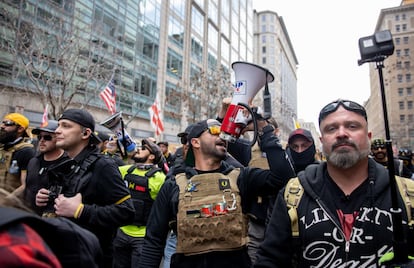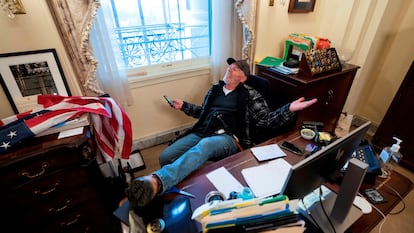Nearly 1,000 defendants and terms of up to 60 years: The Jan. 6 attack on the Capitol is still alive in the courts
The case, the largest in the history of the Department of Justice, is far from over. Members of the Proud Boys are being tried for seditious conspiracy in Washington DC


In many ways, Washington DC is still grappling with the hangover from the Capitol attack of January 6, 2021. Like any good hangover, it’s long-lasting and tends to come back to hit you when you least expect it. Like for instance on January 8 of this year, two days after the low-profile commemoration of the second anniversary of the assault on Washington DC by die-hard Trump supporters, when images came in from Brasilia showing thousands of supporters of another former president, Jair Bolsonaro – as resistant to defeat like Donald Trump – storming Brazil’s democratic institutions.
In the DC courts, however, nobody needs their memory jogged. All proceedings in the “the most important investigation that the Justice Department has ever entered into,” in Attorney General Merrick Garland’s words, end up in the District of Columbia District Court. According to court records, 940 people have been prosecuted for their actions that day, when a mob stormed Congress after attending a Trump rally near the White House. Encouraged by Trump, who was still president, the insurgents attempted to halt what until then had been a little-known element of the democratic process: the certification of Joe Biden’s legitimate victory at the polls.
Two high-profile trials recently coincided at the E. Barrett Prettyman Federal Courthouse. On the fourth floor, five members of the Proud Boys, a violent far-right group whose members feel united – besides the fact of being male – by their admiration for Trump, were being tried. This group drew growing attention in 2020 during the protests that followed the murder by a police officer of the African-American George Floyd.

Two floors up, the jury listened to the first witness, a congressional employee, in the case against Richard “Bigo” Barnett, who became a January 6 icon by photographing himself with his feet up on the desk of the then-speaker of the House of Representatives, the Democrat Nancy Pelosi, to whom he left a note that said: “Nancy, Bigo was here, you bitch” (although his defense claims that he used the slang variant biatch). He has been charged with several counts, including committing and attempting to commit an act to obstruct, impede and interfere with an officer, property theft and breaking into a restricted building with a dangerous weapon. Specifically, a 950,000 volt stun gun (available on Amazon for about $100).
The Proud Boys are facing a much more serious crime: seditious conspiracy, a charge not used lightly in the United States, but for which Stewart Rhodes, leader of the Oath Keepers militia, was found guilty in November. He could face up to 60 years in prison, but his case is exceptional: the average prison sentence at trials so far has been 60 days.
Rhodes met on January 5 in a parking lot with his counterpart at the head of the Proud Boys, the Cuban-American Enrique Tarrio. Both are surely the most prominent figures in the assault on the Capitol, even though Tarrio was not physically there. He followed the attack on television from a Baltimore hotel because the police had barred him from setting foot in Washington that day, following an arrest in the city in December for burning a church’s anti-racist Black Lives Matter banner.

Tarrio listened with apparent detachment on Wednesday morning, exchanging quips and half-smiles with another one of the defendants, Ethan Nordean, as the judge admitted as evidence video footage of Trump instructing the Proud Boys during an election debate. “Back off and stand by,” he told them. Once the adrenaline rush of the attack on the Capitol subsided, Nordean wrote on his social media: “F--- you trump you left us on [t]he battle field bloody and alone.”
Other individuals on trial included Zachary Rehl, Joe Biggs – who tweeted “this is war” after learning of the legitimate concession of election victory to Joe Biden – and Nic Pezzola, who is remembered for images repeated a million times, showing him breaking one of the windows of the Capitol with a shield taken from a policeman. Pezzola was the first person in the crowd to breach Congress.
The prosecution, as in previous cases, is trying to prove that this was not a spontaneous riot, as the defense claims, but an operation planned and led most particularly by Tarrio and his team, and which directly targeted the heart of American democracy. The case also seeks to prove the crypto-fascist gang’s ties to Trump. Those links, which the defendants deny, take up an entire chapter of the 814-page report released just before Christmas by the bipartisan congressional committee that investigated January 6 and its political implications for 18 months. In it, its members conclude that the Proud Boys led the attack, penetrated the Capitol and took hundreds of people inside with them.

It is this anonymous mass of followers that now makes up most of the arrests still taking place throughout the country (and which will continue, warn the authorities). There are so far nearly 1,000 defendants facing charges that range from misdemeanors to felonies, such as entering a restricted federal building or grounds, property destruction or causing serious bodily injury to an officer (the day ended with 140 police officers injured, and four committed suicide in the days that followed). Then there is also the crime of seditious conspiracy, a Civil War-era charge used against Stewart Rhodes and Kelly Meggs, leaders of the far-right Oath Keepers group. As for the defendants themselves, they run the gamut of ages and professions: there is an ex-policeman (Thomas Webster, sentenced to 10 years in prison), an air conditioner technician (Kyle Young, seven years), a nurse, a company CEO, four models (including John Strand, who is facing up to 24 years), a Boy Scout leader, actors (Jacob Chansley, the so-called QAnon shaman and an Olympic medalist.
There is even a complete family, the Munns: the parents and the three children participated in the events. The former received sentences of 14 days; the latter were released on probation. All five belong to something that could be called the January 6 middle class. A good number of them probably didn’t count on committing any crime when they went to the Trump rally. And many have blamed the lies of the former president about election fraud for the mess in which they now find themselves. Others, like Barnett, claim to be victims of “political persecution.”

The squatter in Pelosi’s office, like other defendants, has set up a web page to defend his innocence, and he is accepting donations to cover his legal expenses. He is also raising funds ($22,794 so far) through a conservative affiliation crowdfunding platform called GiveSendGo, which, according to calculations by The Washington Post, It has raised more than $3.7 million dollars for the Jan Sixers, as those arrested and prosecuted for the assault on the Capitol like to call themselves.
There is also a Telegram account that provides links to each of these financing channels, and its administrators always start and end the day in the same way. At night, they lead a collective prayer in memory of the prisoners through a live chat. In the morning, they start the day by sharing a list of the trials that are scheduled in Washington in the following hours. Last Friday, the list added 24 ongoing processes. Two days earlier, a federal court worker defined January 6, 2021 as “the longest day of American democracy”, in a conversation with EL PAÍS. A day that, more than two years later, is still consuming most of the time of officials at the E. Barrett Prettyman courthouse in Washington.
Sign up for our weekly newsletter to get more English-language news coverage from EL PAÍS USA Edition
Tu suscripción se está usando en otro dispositivo
¿Quieres añadir otro usuario a tu suscripción?
Si continúas leyendo en este dispositivo, no se podrá leer en el otro.
FlechaTu suscripción se está usando en otro dispositivo y solo puedes acceder a EL PAÍS desde un dispositivo a la vez.
Si quieres compartir tu cuenta, cambia tu suscripción a la modalidad Premium, así podrás añadir otro usuario. Cada uno accederá con su propia cuenta de email, lo que os permitirá personalizar vuestra experiencia en EL PAÍS.
¿Tienes una suscripción de empresa? Accede aquí para contratar más cuentas.
En el caso de no saber quién está usando tu cuenta, te recomendamos cambiar tu contraseña aquí.
Si decides continuar compartiendo tu cuenta, este mensaje se mostrará en tu dispositivo y en el de la otra persona que está usando tu cuenta de forma indefinida, afectando a tu experiencia de lectura. Puedes consultar aquí los términos y condiciones de la suscripción digital.
More information
Archived In
Últimas noticias
‘I thought you would like it’: The risky sexual practice popularized by TV shows and TikTok
The digitalization of tourism: ‘They promise experiences and gave us the worst possible one’
Mexican peso defies uncertainty with forecasts of a new period of stability in 2026
Meghan Markle’s year of redemption: Numerous projects, some setbacks and a brand that is finally taking off
Most viewed
- Sinaloa Cartel war is taking its toll on Los Chapitos
- Oona Chaplin: ‘I told James Cameron that I was living in a treehouse and starting a permaculture project with a friend’
- Reinhard Genzel, Nobel laureate in physics: ‘One-minute videos will never give you the truth’
- Why the price of coffee has skyrocketed: from Brazilian plantations to specialty coffee houses
- Silver prices are going crazy: This is what’s fueling the rally









































